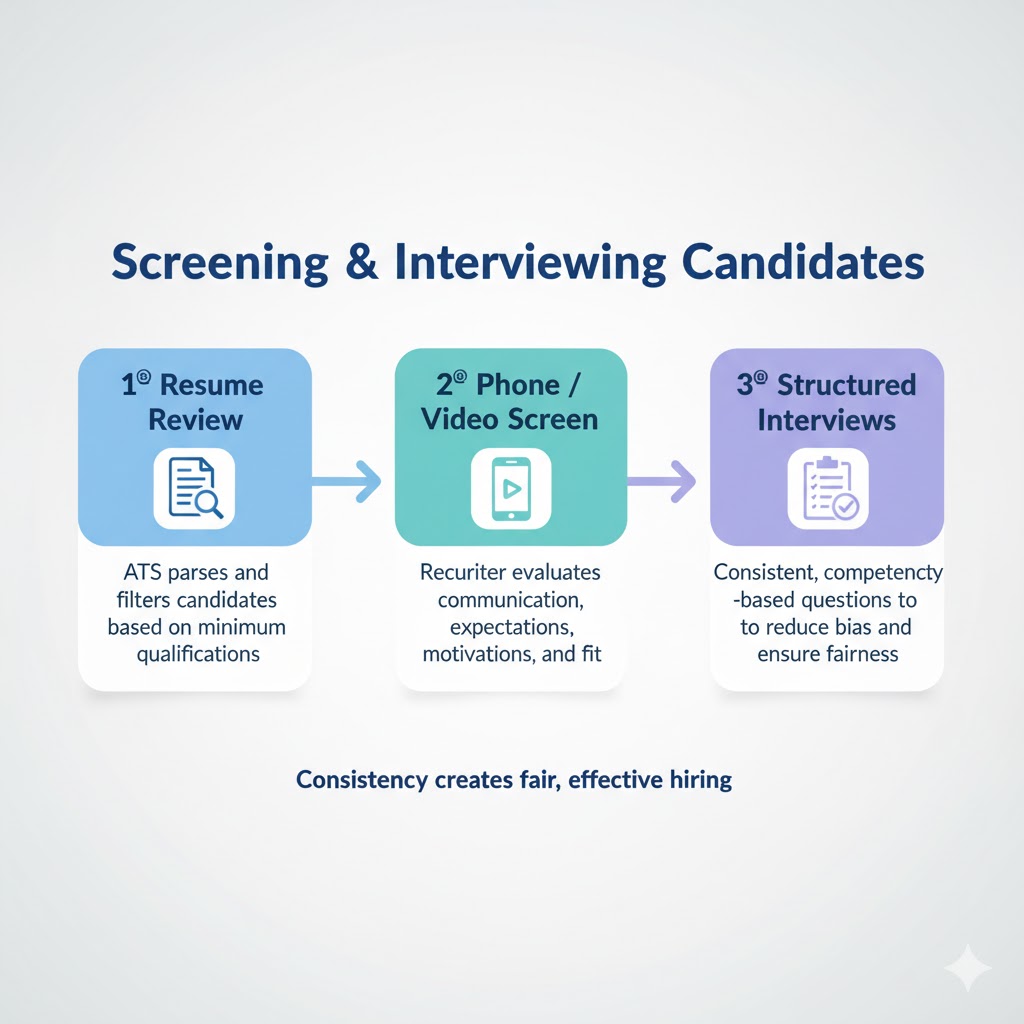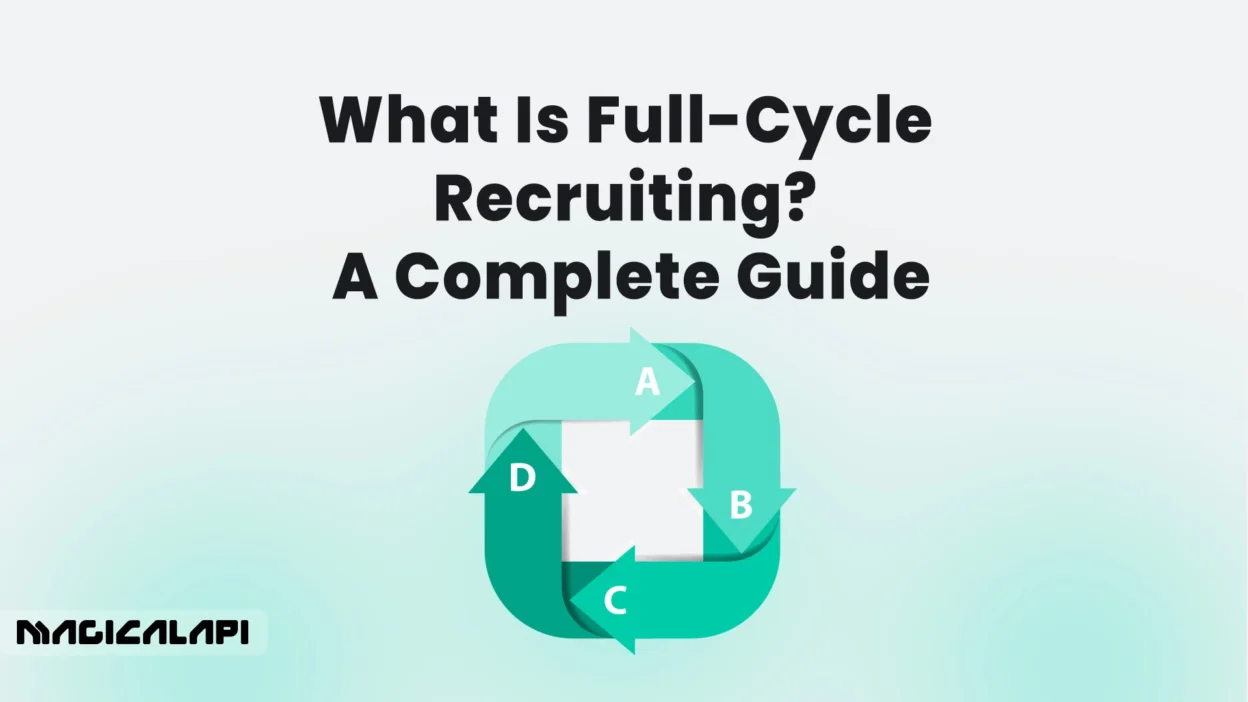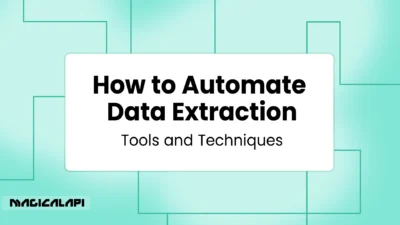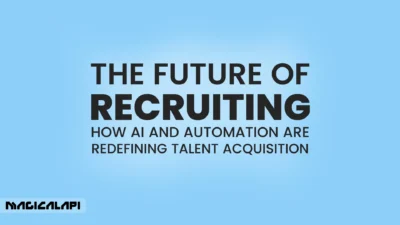The world of talent acquisition is continuously changing and requires a more strategic and holistic mindset from HR practitioners. The emphasis on disjointed hiring practices – which can include screening a candidate through a dozen different individuals – is beginning to fade and has been replaced by a model that emphasizes relationships, consistency, and holistic strategic oversight: full cycle recruiting.
In this detailed guide, you will learn exactly what is full cycle recruiting, benefits of full cycle recruiting, each step of the full cycle recruiting process, and the tools and best practices to embrace modern full-cycle recruiting. Even though the example recruiting processes are for HR leaders, whether you are a solo HR Manager or leading a robust talent acquisition team, understanding the nuances to strategically uncover top talent in the current market is essential.
Table of Contents
What Is Full-Cycle Recruiting?
Full-cycle recruiting (FCR), also commonly known as what is full life cycle recruiting or end-to-end recruiting, is an all-encompassing talent acquisition model where a single recruiter or small dedicated team takes control of the entire hiring process for one particular role. This ownership commences from the moment the hiring need has been identified until the final onboarding of the new employee has been completed.
Essentially, a full-cycle recruiter is a strategic partner, project manager, and relationship builder throughout the entire process. They are responsible for each and every interaction ensuring consistency and always providing a seamless experience for the candidate and the hiring manager alike. This model stands in stark contrast to the traditional fragmented model where tasks are divided across specialized teams (e.g., sourcing specialists, interview schedulers, and onboarding coordinators).
The main premise of full cycle recruiting is integration and accountability. By owning the entire process, recruiters receive greater insights into what works, what does not, and what can be done to improve the pipeline as the process evolves from a transactional process to a strategic function of the business.
The Difference Between Full-Cycle and Fragmented Recruiting
To grasp the strategic implications of FCR, it’s useful to directly compare it to a fragmented model of recruiting.
A fragmented model recruits talent through a series of disjointed stages led by different experts. For example:
- Sourcing is conducted by the Sourcing Specialist,
- Screening and scheduling candidates are completed by a Recruiting Coordinator,
- Interviewing and selection are done with a Hiring Manager and a handful of interviewers, and
- Hiring and paperwork is handled by an HR Administrator.
The fragmented model, using various experts, can cause issues with bottlenecking, miscommunication, and differing candidate experiences since the candidate is continuously “handing off” to a new point of contact.
In contrast, full-cycle recruiting streamlines all of these responsibilities together. The FCR Specialist or FCR Team (should a team be used) is the main point of contact for the candidate and the hiring manager for the full cycle of recruiting. By having one point of accountability, the process becomes a more responsive and personal model that ensures a clear and efficient process, preventing talent from considering dropping out of the process as a result of miscommunication or a slow or chaotic process.
Why Full-Cycle Recruiting Matters in Today’s Hiring Landscape
In a world defined by the “Great Resignation” and intense competition for specialized skills, FCR is no longer a luxury—it’s a necessity. Its importance stems from several key benefits:
- Improved Candidate Experience: FCR enables the recruiter to create an authentic, ongoing relationship with the candidate. Continuous correspondence from a single, well-versed point of contact can eliminate some candidate frustration and maintain candidate involvement, which is important because two-thirds of candidates report that a smooth and timely hiring process is a big deal to the candidate when evaluating an employer.
- Greater Accountability and Ownership: When one person is responsible for the entire process, there’s a clear accountability line. There is no “not my job” mentality and an accountable recruiter is likely to take appropriate action on bottlenecks and inefficiency rather than wait.
- Faster time-to-hire (TTH): When the full-cycle recruiter eliminates any handoff between teams, and retains a strong ownership over scheduling, screening, or offer negotiation process, they will simply hire faster. Constructing an agile cycle is critical because the full-cycle recruiter will need to be in front of rival firms if they are going to convince high-quality talent to accept an employment offer.
- Better Quality of Hire and Retention: The full-cycle recruiter can build a more sophisticated assessment of long-term cultural fit. The full-cycle recruiter has a better view of the role, team culture, and business needs than a separate specialist. This holistic view fosters higher-quality hires with greater engagement who are far less likely to exit the employer within a shorter timeframe.
LinkedIn Profile Scraper - Profile Data
Discover everything you need to know about LinkedIn Profile Scraper , including its features, benefits, and the different options available to help you extract valuable professional data efficiently.
The 6 Essential Stages of Full-Cycle Recruiting
While variations exist, the complete FCR process is generally divided into six critical, integrated stages.
Step 1: Preparing and Understanding Hiring Needs
The process does not begin once you’ve found a candidate; it starts with a need. This is the initial step, which requires further in-depth collaboration between the recruiter and hiring manager.
Key Activities:
- Conduct a Needs Analysis: The recruiter will need to go beyond a job title. The recruiter has to not only know why the position exists, and what the position solves. The recruiter also needs to evaluate what does success look like in six months.
- Develop the Ideal Candidate Profile (ICP): The recruiter will establish the non-negotiable hard skills, the want list of soft skills, and the cultural fit indicators.
- Developing the Job Description (JD): The recruiter will be writing a compelling, accurate JD which serves as a legal document and a marketing tool. The JD will outline the impact of the role – not just a list of activities.
- Setting the Strategy: The recruiter will determine a profile of target candidates, a realistic salary band (based on market data), and the primary sourcing channel to support sourcing.
Step 2: Sourcing Top Talent Effectively
Sourcing refers to the active hunt for passive and active candidates, in which a recruiter uses both technology and market understanding to create a diverse pool of applicants. Effective sourcing is more than just posting jobs; it requires outreach that is strategic and deliberate.
Recruiters leverage up-to-date and sophisticated tools; including technology that can locate, engage, and compile data on potential hires. This can be especially valuable when recruiters are able to access publicly available professional information quickly. Data extraction tools, such as a Linkedin Profile Scraper or Linkedin Company Scraper, allow recruiters to compile structured information on candidates’ work history, skills, and the demographics of their current company.
These tools will automate the manual and time intensive tasks that disrupt the data aggregation process, making it possible for the full-cycle recruiter to engage with personal engagement. Using real-time data from a platform like LinkedIn, the recruiter can ensure that their outreach is timely; relevant; based on the most current facts, and increases response rates and pipeline quality tremendously.
Use Magical API Resume Parser
As a recruiter who handles everything in the recruiting process, your success in sourcing is contingent on how fast you can turn raw data into actionable candidate profiles. This is where integrating powerful APIs from Magical API is crucial. While the action of processing a resume often occurs just prior to the interview, having the ability to quickly standardize your candidate data is critical for a smooth sourcing workflow.
Magical Resume Parser
Discover the powerful capabilities of the Magical Resume Parser and explore the various options available to streamline your hiring process, optimize candidate selection, and enhance recruitment efficiency.
Magical API’s Resume Parser technology automatically extracts, standardizes and scores resume/application data against the job requirements. By embedding this parsing functionality directly into your sourcing pipeline, you guarantee that every candidate lead gathered (either by scraping the profile or direct submission) is instantly categorized and ready for potential review.
This totally eliminates manual data entry, human error, and keeps the focus on qualified candidates from the time they enter the pipeline. The use of this tool streamlines a tremendous amount of data processing in one quick, automated step, and this frees up the full-cycle recruiter to spend more time on high-value engagement and relationship building.
Step 3: Screening and Interviewing Candidates
After identifying potential candidates, the recruiter takes over the evaluation, or assessment, stage, which may be the most important stage to control consistency. The screening part of the evaluation process includes:
- Initial Application / Resume Review: Candidate resumes are first quickly reviewed against minimum qualifications. Modern applicant tracking systems use a Resume Parser to automatically extract, structure, and score relevant data from the resume against the job descriptions, which accelerates the candidate pool’s first filter and the likelihood that the focus will remain on candidates who meet the minimum.
- Recruiter Phone / Video Screen: This initial discussion with the candidate will evaluate their communication abilities, compensation expectations, reasons for seeking a new employer, and likely cultural fit. This is the first opportunity for the full-cycle recruiter to establish rapport with the candidate and set clear expectations about what is to come through the hiring journey.
- Structured Interviews: The recruiter will coordinate the structured interviews for the hiring team, making certain that all interviewers are asking the same competency-based interview questions and scoring candidates in a consistent manner, so that it is easier to eliminate bias and impose fairness throughout the process.
In addition to those areas, the full-cycle recruiter supervises all of the feedback, coordinates the interview scheduling, and continues to communicate with the candidate about potential updates all in ways that are timely and considered to build excitement moving forward.

Step 4: Making the Job Offer and Negotiating Terms
This phase requires strong negotiation skills; emotional intelligence; and a solid understanding of market compensation. The full-cycle recruiter acts as a conduit between what a candidate wants and what the company is able to pay.
Key Activities:
- Compiling the Offer: Confirming the offer letter is accurate, enticing, and clearly outlines salary, benefits, start date, and contingencies (e.g., background checks).
- Presenting/Negotiating the Offer: Presenting the offer with energy and confidence, as well as handling any counter-offers or negotiations. The rapport built in the earlier stages will play a meaningful role in getting the candidate to initially accept.
- Reference and Background Check: Quickly facilitating these remaining administrative steps so the candidate isn’t delayed from accepting any competing offers.
Step 5: Onboarding, The Start of Long-Term Retention
For a full-cycle recruiter, the activity is not finished when the offer is signed—it’s finished only when the new hire is onboarded successfully. The final stage doesn’t often receive the attention it needs, but it is essential for retention.
Effective Onboarding Includes:
- Pre-Boarding Communications: Sending “welcome” information, following up about paperwork, coordinating a plan for the first day of the new hire, and building engagement prior to the start date while reducing first-day anxiety.
- Facilitating the Handoff to HR/Manager: The full-cycle recruiter facilitates the transition of responsibility to HR for ongoing administration and the hiring manager for performance coaching.
- Post-Hire Check-ins: Checking in with the agent/new hire at 30, 60, and 90-days post-hire for feedback about the recruiting experience, which helps fuel the continuous feedback loop, which is the process of refining the FCR process.
Tools and Technologies That Streamline Full-Cycle Recruiting
In a modern company, the success of what is full cycle recruiting is linked to having a strong tech stack; where one individual can handle end to end recruitment across multiple positions while preserving quality.
The building block is the ATS, the Applicant Tracking System, which is the hub of your candidate data, scheduling, and communication. Surrounding it are the necessary tools to help engage automation for high-volume tasks:
- Sourcing Automation: As outlined in step 2, a high level of API’s and scrapers can dramatically eliminate the demand to source for data. When combined with an AI Recruiting Assistant, these tools can perform personalized outreach campaigns for passive candidates too, acting as a force multiplier for the recruiter.
- Screening and Assessment Tools: In addition to our Resume Parser functionality, systems can utilize skills tests, behavioral assessments, and video interviews as objective data points for candidate selection.
- Recruitment Automation Tools: These tools will assist with repetitive administrative tasks, like scheduling the interview, sending interview reminders and collecting post-interview feedback forms, or updating the candidate status to allow the full-cycle recruiter to focus on their strategic, high-touch tasks like negotiation and candidate engagement.
By carefully selecting and integrating these tools, an organization can provide its full-cycle recruiters with the support necessary to handle the increased scope of responsibility successfully.
Measuring Success: Key Performance Indicators (KPIs) for Full-Cycle Recruiters
The strength of FCR is the broad data perspective it provides. Owning the whole funnel allows the recruiter to have access to all KPIs throughout the cycle, as opposed to KPIs found in distinct segments.
Examples of metrics to assess and improve upon include:
- Time-to-Hire (TTH): The time from the approved job requisition to when the candidate accepts the offer. Generally speaking, the lower the TTH, the stronger the FCR process.
- Source of Hire (SOH) Effectiveness: Tracking which sourcing channels (referrals, job boards, passive sourcing) continues to yield the best candidates. This will allow recruiters to capitalize on sourcing budget and time.
- Offer Acceptance Rate (OAR): The percentage of formal offers accepted. High OAR indicates the recruiter is skilled at relationship building and offers negotiation.
- Quality of Hire (QoH): A measure often derived from the new hire’s performance rating, retention rate (e.g. after 6 or 12 months) and feedback from the hiring manager. This tells us that the full cycle achieved the long-term result we desired.
- Candidate Experience (CX) Scores: Measured through short survey responses sent at crucial points (e.g. after phone screen, after offer). High CX scores is another indicator of a positive employer brand and a pipeline of future candidates.
LinkedIn Company Scraper - Company Data
Discover everything you need to know about LinkedIn Company Scraper , including its features, benefits, and the various options available to streamline data extraction for your business needs.
Full cycle recruiting Best Practices and Common Mistakes to Avoid
To perfect FCR, it is important to have a mindset of strategy and continuation rather than simply tagging all responsibility on one individual:
Best Practices
- Make Calibration Matter More Than Your Speed: Spend a great deal of time in Preparation stage (Step 1). Before you post a job, spend time confirming the skill set, pay range, team dynamics (Walking the Talk) with talent manager. You will be much more effective and avoid any rehired resumes.
- Communicate, Communicate, Communicate: Zeitgeist will serve as clear communication with each candidate as to expectations of timelines, structure of interview, and all feedback periods. Ghosting candidates in any capacity is the single fastest way to damage an employer brand.
- Utilize Scalable Technology: Make sure your ATS and sourcing capabilities are followed forward with your growth as an organization. Relying on manual spreadsheets and ad-hoc technology will deplete any efficiencies of FCR in the speeds of hiring.
- Use of Data: The beauty of the FCR process, all the data collected through the Talentelevations Cycle (TTH, SOH) should be utilized equally as always to really take your data, and refine your strategy. If one channel is not working source it somewhere else.
Common Mistakes to Avoid
- Becoming overly transactional: A full-cycle recruiter’s role consists of managing relationships. Looking at candidates as if they were only job-fillers, and not potential long-term employees, leave with little engagement and disengage from offers.
- Ignoring onboarding: This is a major mistake. Halting work once the offer is accepted is misguided. The last phase of full cycle recruiting really brings the new employee into the fold and checks the quality of the overall process.
- Failing to manage hiring manager expectations: Recruiters must be consultants. If the hiring manager is realistic, it is important to push back politely based on the salary, the availability of candidates, or how long the interview process takes.
- Inconsistency of process: Conducting disorganized or non-structured interviews creates a sense of unprofessionalism within the company and relies on potential bias to make selection assessments.
Transitioning to a Full-Cycle Model: A Roadmap for HR Teams
Moving from a fragmented model to a full cycle recruiting approach requires deliberate planning and change management. It’s not just about restructuring tasks; it’s about reshaping roles and responsibilities.
- Evaluate Current Capabilities: Assess your current recruiting team’s skill set.FCR requires strong skills in sourcing, screening, negotiating, and relationship management. Identify any skills gaps and then deeply invest in training.
- Test the FCR Model: Do not shift all at once. Start with a less-critical business unit or role type (e.g., specialized technical hires) to try out the new workflow, obtain feedback, and adapt the process before implementing it on a wider basis.
- Define Clear Accountability Structures: Document in formal style the positions, expectations, and key metrics that the full cycle recruiting will be responsible for, including defining exactly when the hand-off to the post hire HR/Onboarding team will take place.
- Provide the Team with the Appropriate Technology: Confirm that your recruiters have access to the data and Recruitment Automation Tools available to allow them to expand upon workload capacity. This includes system design processes like AI Recruiting Assistant to automate initial outreach and candidate nurturing.
- Create Partnerships: While the FCR oversees the process, the success of the hire is still a team effort. Mandatory, structured check-ins should take place between the FCR and hiring managers to mutually identify that they are working collaboratively on the talent acquisition project.
Conclusion: The complete cycle recruitment
The complete cycle recruitment (CCR) is the most advanced and productive approach for talent acquisition in today’s business climate. It centralizes accountability and consistency across all 6 stages – preparation, sourcing, screening, selection, negotiation, and onboarding.
Implementing a CCR model improves transparency for the candidate experience, expedites time-to-hire, and improves the quality of the entire workforce. Organizing the right tools, training, and processes that complement this holistic approach isn’t just simply HR; it’s a key business approach for growth with a competitive advantage.
FAQs for full cycle recruiting
1. What is the number one advantage of a single full cycle recruiting doing all stages?
The number one advantage is consistency and the candidate experience. Having a single point of contact can create a deeper rapport, faster communication, and will alleviate the confusion and friction that exists when multiple team members are transitioning candidates through a fragmented process. This will greatly reduce drop-off rates and improve the employer brand.
2. Is full cycle recruiting only for small companies?
No. While small companies have relief to FCR by default, larger organizations can use it to their advantage by creating specialized FCR teams for departments or job families (i.e., a “Technical full cycle recruiting Team” or “Sales Full- Cycle Team”). In this way, the organization creates end-to-end accountability while providing the opportunity to scale a model.
3. How does FCR relate to candidate relationship management (CRM)?
FCR fits naturally with CRM, as it is focused on the recruiter being responsible for creating rapport with candidates, especially passive candidates, throughout the process. Using a Recruitment Automation tool often provides dedicated CRM features that allow the FCR to segment the candidate pool, send personalized follow-up messaging, and manage a pipeline filled with candidates for future openings.





